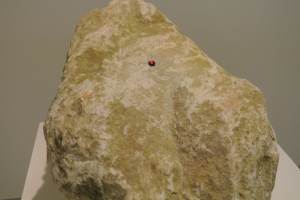The LED blinks on and off. We could be here a while. As deep history has shown, a rock like this can take its own sweet time to breathe forth life, or yawn and swallow us all.
Just whose hand might go to the remote to activate a 80kg lump of sandstone? Would it be a god, or an artist, or an artist who thinks they might be a god? Or even a reviewer.
A classical sculptor could make something of this proposition. From Michelangelo to Brancusi, the chisel and hammer have been switching on stones in the name of art.
But this is a digital rock, so that wouldn’t appear to work. We have enough animate objects in our homes. We no longer need figurines, no longer need expressive miracles.
The red glow of the pilot light is miracle enough. It appears to take its power from deep inside its core. No one plugged in this boulder;Â it is pure potential.
Mind you, Rock on Standby is already activated to some degree by a plinth, a photo, a blog post. Are not all inert works of art on standby in this familiar sense? A collector would certainly trigger it.
As possessors of eyes, etc., we come ready to push buttons. Until then, we might be on standby too. In fact, we are the ones who really come to life around this piece.
We cannot look away from this collision between two speeds: geological time and recent speeds like broadband and 4G. We can hardly get faster. This rock reminds us how far we’ve come.
It also hints at the speed of the rock on which we live: about 30km per second. The Earth too is on standby, primed for natural disaster, a likelihood we are also accelerating.
So nice to know the artist hasn’t lost his sense of humour. If you could ROFL in a gallery without being ejected, you just might. This heavy piece of work has the lightest of touches.
Tom Dale: Terminal Blue can be seen at John Hansard Gallery, Southampton, until 7 February 2015. For more on this artist see my previous posts here, here, and here.
